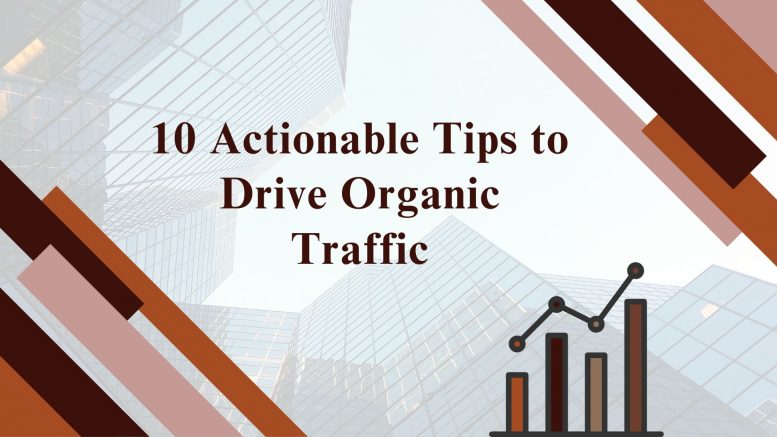In these days’s digital-first world, an organization, as well as a content material creator, cannot function without a robust on-line presence. Organic visitors are the unpaid page visitors from search engines like google and yahoo. Organic visitors will be one of the maximum sustainable approaches to expand your target market and gather your dreams. Unlike paid advertising and marketing, organic marketing strategies awareness on growing fees that attract customers obviously throughout the years. This article dives deep into actionable hints that are going to help you improve your organic traffic and create a solid foundation for long-term online success.
Here are the Top 10 Actionable Tips to Drive Organic Traffic
1.Conduct In-Depth Keyword Research
Start by identifying key phrases that resonate with your target audience. Use equipment like Google Keyword Planner, SEMrush, or Ahrefs to find high-visitors, low-opposition key phrases. Prioritize lengthy-tail key phrases as they may be extra unique, frequently leading to higher conversions. For instance, in place of focused on “fitness,” intention for “domestic workout workouts for beginners.”
2.Optimize Your On-Page SEO
On-page SEO plays a pivotal role in driving organic traffic. Pay attention to:
- Title Tags: Ensure each web page has a unique, key-word-rich identify.
- Meta Descriptions: Craft compelling descriptions that inspire clicks.
- Header Tags: Use H1, H2, and H3 tags efficaciously to shape your content.
- Alt Text for Images: Describe your photographs the usage of applicable key phrases.
These efforts help search engines understand your content and improve your rankings.
3.Create High-Quality, Engaging Content
Content stays king in search engine marketing. Produce content material that addresses your goal market’s questions, solves problems, or offers insightful suggestions. Here’s how to make your content material stand out:
- Evergreen Content: Create articles, publications, and tutorials that stay relevant over the years.
- Trending Topics: Capitalize on current occasions or trends on your industry.
- Storytelling: Engage your readers emotionally with relatable stories.
For instance, a detailed blog publish like “10 Yoga Poses for Better Sleep” should appeal to a gap target audience at the same time as presenting actionable value.
4.Leverage Internal Linking
Internal links not only guide users but also help search engines crawl and index your website more effectively. Best practices include:
- Linking to older but relevant posts.
- Using descriptive anchor text with keywords.
- Ensuring a natural flow to improve user experience.
For instance, if you mention “SEO tips,” link it to a related in-depth article on your website.
5.Build High-Quality Backlinks
Earning backlinks from reputable sources signals to search engines that your content is valuable. Here’s how you can achieve this:
- Guest Posting: Write for enterprise-applicable blogs.
- HARO (Help A Reporter Out): Provide professional reviews to journalists.
- Infographics: Design shareable visuals with embedded backlinks.
Focus on quality over quantity to ensure sustainable growth.
6.Optimize for Mobile Usability
With mobile-first indexing, your website must perform flawlessly on smartphones and tablets. Essential steps include:
- Adopting responsive design.
- Improving loading speed.
- Simplifying navigation and button placement.
Google’s Mobile-Friendly Test tool can help assess your site’s readiness.
7.Improve Website Loading Speed
Slow websites can deter users and lower your rankings. Optimize your loading speed by:
- Compressing Images: Use tools like TinyPNG or ImageOptim.
- Browser Caching: Store static files locally to reduce load times.
- Content Delivery Networks (CDN): Distribute your website globally for faster delivery.
Even a one-second delay in loading time can significantly impact user experience and traffic.
8.Utilize Social Media Platforms
Social media can amplify your reach and direct traffic to your website. Consider:
- Sharing blog posts on systems like LinkedIn, Facebook, and Twitter.
- Using visuals, motion pictures, and polls to engage followers.
- Collaborating with influencers to your niche.
Consistent posting and interaction can establish your brand as a thought leader.
9.Implement Schema Markup
Schema markup allows search engines like google and yahoo recognize your content material better, that could beautify your seek listings. Rich snippets, which includes megastar rankings or FAQs, entice greater clicks. Common kinds of schema encompass:
- FAQ Schema: Perfect for answering common questions.
- Product Schema: Showcase product details.
- Review Schema: Display customer feedback.
Use tools like Google’s Structured Data Markup Helper to implement schema on your website.
10.Analyze and Refine Your Strategy
Continuously monitor your performance using tools like Google Analytics, Search Console, and Ahrefs. Key metrics to track include:
- Organic Traffic Trends
- Bounce Rate
- Click-Through Rate (CTR)
- Conversion Rates
Identify what works and adapt your strategy to improve results. For instance, if a particular blog post is driving traffic, consider creating more content around that topic.
Conclusion
Boosting natural visitors requires a combination of method, staying power, and consistency. By enforcing the recommendations shared in this guide, you may improve your internet site’s visibility, interact your target audience, and acquire long-term fulfillment. Remember, search engine optimization isn’t a one-time task but an ongoing manner. Stay updated with the contemporary tendencies, refine your technique based on analytics, and maintain handing over fee on your target audience. Over time, your efforts will translate into sustainable boom and better on-line presence


Be the first to comment on "10 Actionable Tips to Drive Organic Traffic"